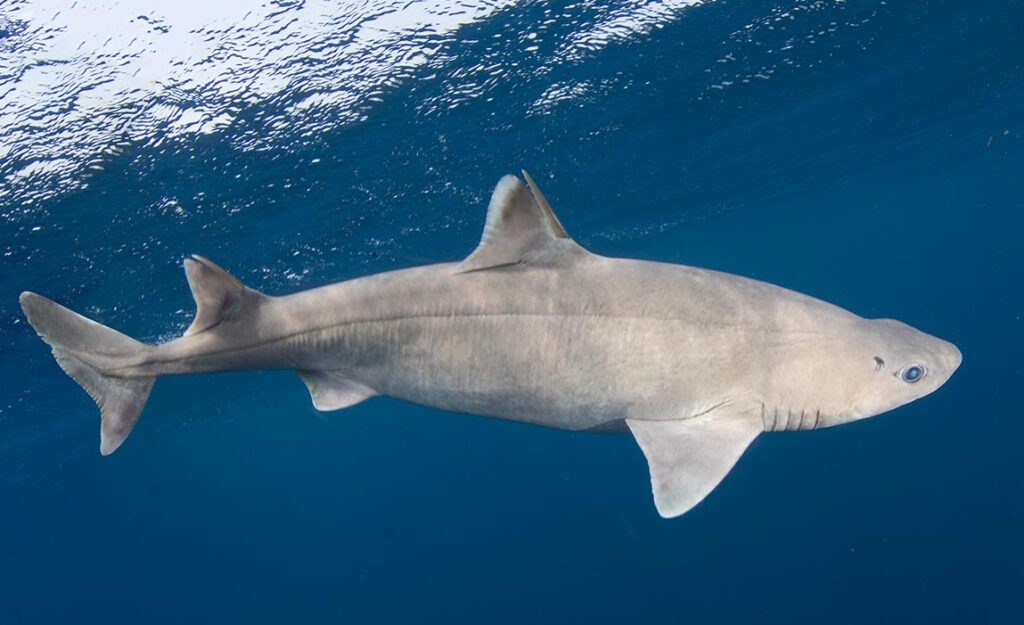Alongside its biological and behavioral features, the roughskin dogfish deep sea creature species of shark (Centroscymnus Estonia) is a source of admiration for both marine biologists and ocean enthusiasts around the world. Its unique adaptations and anatomy catch the attention of all. Roughskin dogfish deep sea sharks, along with other members of this family, thrive at the bottom of the ocean and are often covered with mystery due to their behavior. In this blog, we will answer the questions and provide insights into this deep sea wonder that ranges from its habitat, physical traits, feeding patterns, and behavioral traits.
What is the Roughskin Dogfish?
The roughskin dogfish deep sea sharks are part of the sleeper shark family (Somniosidae). As the name suggests, this family of sharks is slow-moving, capable of reaching tremendous depths. Their bodies are covered in rough, sandpaper-like skin that drags slightly when they move, providing much-needed protection.
Family: Somniosidae
Distribution: Atlantic, Pacific, and Indian Oceans
Scientific Name: Centroscymnus Estonia
Depth Range: They generally prefer depths of 200 to 1500 meters, but they can go deeper than this regular range.
Habitat and Distribution
The roughskin dogfish deep sea shark belongs to a group of species where sunlight does not reach, making it a primary deepwater shark. These species are usually located in areas such as continental slopes, ocean trenches, and underwater mountains. Their life in the abyss is made possible by their adaptations to low temperatures and high pressure.
Key Habitat Features:
- Depth: 200-1,500 meters
- Regions: Notable populations are distributed across the Atlantic, Pacific, and Indian Oceans, particularly near Japan, New Zealand, and the Eastern United States.
- Temperature Tolerance: These populations thrive in deep-sea environments with temperatures just above freezing.
Physical Characteristics
The roughskin dogfish deep sea shark species is known to be on the small side but is tough enough to survive the harsh conditions of the deep ocean.
- Size: Adults typically grow up to around 1 meter in length.
- Color: These sharks have a dark brown to blackish color that helps them camouflage in the dark depths.
- Skin: Their skin’s rough texture helps them move efficiently through water.
- Eyes: Large and sensitive eyes allow them to see prey at low depths.
Diet and Feeding Behavior
The roughskin dogfish deep sea shark feeds on fish, squid, and other small marine critters, including other ocean organisms. They are opportunistic feeders with no preference for a specific type of meal.
Feeding Adaptations:
- Stealthy Movement: Helps conserve energy in food-scarce areas.
- Ambush Hunting: Enables the shark to surprise prey through stealth.
- Triangular Sharp Teeth: Their strong jaws with sharp triangular teeth help grip slippery prey.
Deep-Sea Survival Adaptations
Surviving in the deep sea is tough. Fortunately, the roughskin dogfish deep sea shark has remarkable adaptations:
- Low Metabolism: Allows these sharks to live on a limited food supply.
- Neutral Buoyancy: Reduces the high energy cost of swimming and allows them to effortlessly drift in water.
- Camouflage: Their dark skin makes them nearly invisible to both predators and prey.
- Electroreception: Helps them detect electric fields from other animals, facilitating easier prey detection.
Reproductive Strategies and Developmental Stages
Roughskin dogfish deep sea sharks are ovoviviparous, meaning live young are birthed from eggs that hatch inside the female’s body. This reproductive strategy is advantageous in the deep ocean where predators are few but environmental challenges are significant.
Key Reproductive Facets:
- Gestation Period: Long, but details are unclear.
- Litter Size: Small, typically just a few pups per breeding cycle.
- Juvenile Development: Sharks are born alive and are self-sufficient from birth.
Why Is the Roughskin Dogfish a Significant Player?
The roughskin dogfish is a key player in the deep-sea ecosystem. It acts as a predator, helping control the population of other species in its area. It is also scientifically significant, providing insight into the delicate mechanisms of deep-sea biological life.
Commonly Asked Questions: Roughskin Dogfish
1. What’s the Vertical Reach of the Roughskin Dogfish Deep Sea Shark?
The roughskin dogfish deep sea shark typically inhabits depths from 200 to 1500 meters but has been sighted at even greater depths.
2. Can the Roughskin Dogfish Be a Threat to Humans?
No, the roughskin dogfish is not a danger to humans. It lives in remote deep-sea areas with little or no human activity and feeds primarily on very small marine animals.
3. Who Poses the Biggest Danger to Roughskin Dogfish?
The biggest threat to rough skin dogfish deep sea sharks comes from over-harvesting and deep-sea trawling. These activities impact their habitat and populations.
Conservation Status
Despite limited research, the roughskin dogfish faces potential risks from deep-sea fishing and habitat destruction. It is important to monitor and protect this species to maintain ocean biodiversity.
Final Thoughts
The roughskin dogfish is a marvelous deep-sea creature that lives in one of the most extreme conditions on Earth. These sharks are admired for their biology, behaviors, and adaptations, which continue to prompt scientific investigation. As we learn more about deep sea species, we can better appreciate these delicate ecosystems and work to protect them.
Share Your Thoughts!
Have you ever tried looking for a roughskin dogfish deep sea shark? Feel free to leave your thoughts and questions in the comment section below. With over 1,500 species of sharks discovered worldwide, it’s surprising how few people know about the roughskin dogfish’s existence!



1 Comment
Your blog is always a great source of knowledge and inspiration. Thanks for sharing your thoughts and ideas.